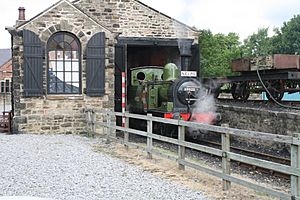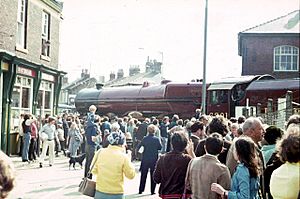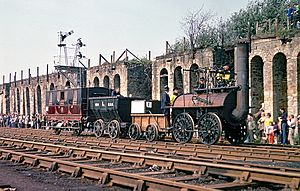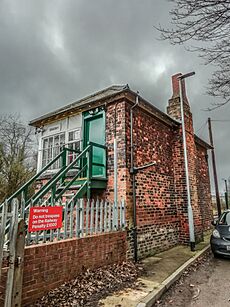Shildon facts for kids
Quick facts for kids Shildon |
|
|---|---|
 Church Street |
|
| Population | 9,976 (2011 Census) |
| OS grid reference | NZ226263 |
| • London | 225 mi (362 km) |
| Civil parish |
|
| Unitary authority |
|
| Ceremonial county | |
| Region | |
| Country | England |
| Sovereign state | United Kingdom |
| Post town | SHILDON |
| Postcode district | DL4 |
| Dialling code | 01388 |
| Police | Durham |
| Fire | County Durham and Darlington |
| Ambulance | North East |
| EU Parliament | North East England |
| UK Parliament |
|
| Website | https://shildon.gov.uk |
Shildon is a town and civil parish in County Durham, in England. The population taken at the 2011 Census was 9,976. The town has the Locomotion Museum, due to it having the first Shildon, built in 1825, and locomotive works on the Stockton and Darlington Railway.
Contents
History
Shildon's earliest settlers were groups of people who lived during the Mesolithic period some 6,000 years ago. They lived by collecting wild plants and hunting wild animals. There was a small prehistoric flint tool found in the Brusselton area which may have been of this date.
Romans arrived in County Durham in the 1st century AD and built a line of forts along the Roman road leading north to Hadrian's Wall. Traces of Roman roads have been found at several places in Shildon, such as Brusselton Wood. Small settlements grew up in places alongside the course of the road.
By the end of the Anglo-Saxon period the village was established as one of the settlements in the area. Various mediaeval settlements stood around Thickley.
The Shildon area owes its growth to the rise of the East Durham coalfields in the Industrial Revolution of the late 18th and early 19th century.
Railway history
The expansion of coal mining during the Industrial Revolution meant the traditional way of moving the coal along horse-drawn wagon ways was insufficient. Steam engines were introduced. At first static engines pulled the wagons, but were replaced by moving engines on railways.
Shildon is considered to be the "cradle of the railways". The town grew when the Stockton and Darlington Railway established its workshops in 1825. Steam locomotives such as the Sans Pareil and Royal George were built there. During this period the population grew to around 9,000. By 1855 it was a large complex of workshops and other buildings. After the Second World War, Shildon had one of the biggest sidings complexes in Europe. The Shildon Works eventually closed in 1984. The site now houses Shildon Locomotion Museum, which opened in September 2004 and is an extension of the National Railway Museum.
George Stephenson built a track from Witton Park to Stockton-on-Tees. Static engines pulled the coal wagons over Brussleton, after which they were attached to steam engines. The remains of a static engine house can be seen at Brusselton. Originally the railway carried only coal, but demand led to passengers being carried. The first passenger train began its journey in Shildon on 27 September 1825.
Shildon was the home of Timothy Hackworth, an innovator of the railway industry and builder of one of the first ever engines, the Sans Pareil. It is also the birthplace of Daniel Adamson, Hackworth's apprentice and engineer.
Shildon and the Locomotion Museum are served by Shildon railway station on the Tees Valley Line.
Railway heritage
19th century
At the dawn of the 19th century Shildon was a few houses on a crossroad. The Industrial Revolution and the coming of the railways saw the town grow. In 1801 the population was recorded at being 100 people. Their occupations were noted as being in agriculture, coal mining and the growing textiles industry.
In 1818 notice was given in the London Gazette '...that application is intended to be made to Parliament in the next session, for an Act for making and maintaining a 'rail-way or tram-road from the River Tees, at or near Stockton, in the county of Durham', with Shildon listed as one of the towns on the planned route.
John Dixon, assistant to George Stephenson recalled the town before the railways came.
The volume of coal being produced by coal mining outstripped the capacity of the traditional method of transporting coal, on horse-drawn wagon ways. Steam power was introduced through the use of static steam engines. These were, in turn, were superseded by steam locomotives. Coal would be pulled by static engines over Brusselton Incline into Shildon where the wagons would be attached to a locomotive.
The population grew with this industrial expansion, the population rising from 115 in 1821, to 2,631 in 1841 up to 11,759 by the end of the century. Records show in 1851 the town had 447 houses that were inhabited and 26 uninhabited. Two years later the value of property in the town was assessed at £11,269 and 10 Shillings.
Demand led to a passenger service beginning from the town on 27 September 1825. The first train, Locomotion No.1 began its journey outside the Mason's Arms Public house. There is an argument that the Mason's Arms could be classified as the world's first railway station. In the early stages of the Stockton and Darlington Railway, tickets were sold at the bar. Between 1833 and 1841 the company hired a room in the pub for use as a booking office.
The railway ran from its northern terminus at Shildon along 27 miles of track to its terminus at Stockton. In 1838 the speed of travel was noted by The Derby Mercury which reported that a servant asked permission to travel to Shildon from Stockton on Christmas Day. She made her request "a little before four in the afternoon" and was able to return home "by seven o'clock the same evening".
Recruited to the railway by George Stephenson in 1824, Timothy Hackworth went on to become superintendent in 1825. He was charged with building locomotives for the company.
Engine works
Timothy Hackworth moved into Hackworth House (formerly Soho House, now Grade II* listed) with his family in 1831. There he supervised the construction of what became the Soho Engine Works close to the property. In 1833 Hackworth renegotiated his contract with the Stockton and Darlington Railway to take over the works himself. This became the Soho Locomotive Building Company.
Hackworth was in a partnership with Nicholas Downing in Shildon however the partnership was formally dissolved on 25 March 1837.
The oldest part still surviving is the Soho Shed. The grade II* listed building was built in 1826 as a warehouse for an iron merchant. The North Eastern Railway were the occupant from 1863 before becoming a paint shop for trains in the 1870s. In the 20th century it was used as a boxing gym and rehearsal space for the Shildon Works Silver Band. The shed still has two engine pits and the remnants of a 19th-century heating system. The engine shed along with Hackworth House was refurbished in 1975.
Near the Soho Shed, 110 metres to the east, are the grade II* listed coal drops. Constructed circa 1846/47 or circa 1856 depending on source. The system was used for the refuelling of locomotive tenders. Coal wagons would be hauled to the top of the coal drops where their bottom would open and the coal would fall down a chute into the engine waiting below. (Hackworth House, the engine shed and the coal drops were all raised from Grade II to Grade II* on 11 May 2021.)
In this area also stand the Black Boy Stables and out buildings. The grade II listed stables were built in the early 19th century at the point where the branch lines met from the Black Boy Colliery and Surtees Railway. Restored in the 1970s the stables were damaged by fire in 1985. However, a 2016 report disputes their being stables. It states that while they are "clearly not stables", it believes one was possibly a plate layer's cabin. The use of the other "adjacent structures is still in some doubt". Other buildings include the goods shed and parcels office. It handled local freight distribution in Shildon from 1857. The parcels office looked after the movement of goods in and out of the shed.
The Soho Works built the first locomotive to run in Nova Scotia, Canada. The engine, named Samson, was shipped from Shildon in August 1838 to move coal from the coal mines at Stellarton.
The Stockton and Darlington Railway expanded their works on the western side of the Mason's Arms Crossing. This expansion alongside the nearby Soho works led to a surge in population as people came to the town for work. The pace of growth quickened further with the opening of Shildon Colliery to the south of the Soho Works in 1873.
In 1855 the Soho Works were bought by the Stockton and Darlington Railway and made an extension of their works. Now merged with the North Eastern Railway in 1863 and locomotive production was shifted to their North Road Works in Darlington. The Shildon Works continued but focus was shifted to the construction of railway wagons.
20th century
A strike in 1911 saw violent scenes in the town and British troops deployed to maintain order. ..... He was pursued by an angry mob and had to be rescued by soldiers. Mineral wagons had their bottom doors undone and the contents allowed to fall out. Wagons in the sidings had their brakes undone and freewheeled for miles, railway signal cables were damaged and the cavalry had to be called. At one stage soldiers had to mount a Bayonet charge to clear a bridge. The New Shildon Strike Committee condemned the government for deploying the army and called for their withdrawal.
Moving further into the 20th Century the Shildon Works became the largest wagon works in the world by 1976, employing 2,600 people. The works built 1,000 wagons a year and repaired more besides. The 27 miles of sidings made Shildon home to what was believed to be the largest sidings in the world. This was until the construction of the Chicago marshalling yards in 1927.
There were concerns for the future of the railway works in the 1930s. The London and North Eastern Railway Company had decided to concentrate their operations to Darlington. Local MP Aaron Curry addressed the matter in the House of Commons on 14 December 1934.
The Soho works laid derelict since the 1940s and were scheduled for demolition in the 1970s when many of the buildings fell into disrepair. However, the buildings were saved when they were restored and opened to the public as part of the Timothy Hackworth Museum. The museum was opened on Thursday 17 July 1975 by Her Majesty, Queen Elizabeth The Queen Mother.
Railway works closure
The railway works closed on 29 June 1984, with the loss of 1,750 jobs. David Mitchell MP, Transport Under-Secretary, opened the Hackworth Industrial Park on the site of the wagon works in 1985. The Shildon and Sedgefield Development Agency was established with a £1.6 million fund given by British Rail Engineering Limited (BREL) and also had backing from Shildon and Sedgfield Councils. The agency (as of 1985) spent £1 million in marketing the former workshops, giving loan guarantees as well giving business advice. The agency supported 100 companies with 57 being start ups and also paid £30 a week for a year to companies taking on former BREL staff.
Coach house
Shildon is also home to the grade II listed Daniel Adamson's Coach House (c.1831). In 1827 Daniel Adamson, landlord of the nearby Grey Horse pub, had a horse-drawn railway coach called Perseverance which ran between Shildon and Darlington. When the Surtees Railway opened in 1831, Adamson built the coach house. The building was to act as both station and shed. It is believed to be the earliest surviving railway coach house in the world. His son, also Daniel Adamson, became an engineer.
Brusselton incline
On the edge of Shildon is the hamlet of Brusselton. Two hills barred the way from the south Durham coalfield to the start of the railway at Shildon. George Stephenson overcame this by setting up stationary steam engines on the hilltops to haul the coal wagons over. One engine was at Etherley, this brought the wagons from Witton Park and lowered them down the slope to West Auckland. From there horses took the wagons to the Brusselton incline. At the top of this in an engine house were two 30 horsepower engines (later upgraded to a new 80 horsepower engine) acting in tandem. A large drum hanging above the road holding a rope pulled the wagons over the incline and to the locomotive waiting in Shildon.
A boiler house, chimney and railwaymen's houses sat on the north side of the road but have since been demolished. The engineman's house on the south side of the road still survives. A passenger service began over the incline in 1833 and a record set in 1839 with 2,120 tonnes of coal taken in 67 trips in a day.
The enginemen at the top of the incline were told when wagons (a mile and a half distant) were ready to make the ascent by means of a disc on the end of a tall pole. When the disc was set spinning the wagons were ready. To observe the spinning disc a telescope was set up. This is believed to be the first recorded railway signalling system in the world. In the event of fog, long wires with bells or rappers attached were used.
There were concerns about runaway wagons in the event of the rope snapping. The wagons' brakes could only be activated on board. For this reason young boys were employed to stand at the side of the track and run alongside in the event of a runaway wagon, jump aboard and apply the brake. At the bottom of the incline men were positioned with tree trunks and huge blocks of wood to cause a deliberate derailment in the event of an emergency by throwing them on the line.
To the west of Brusselton there were three bridges, the most westerly taking the railway under the Dere Street Roman road. The bridge is now gone but a 1925 article from the Northern Echo offers a description of what early rail passengers would have experienced.
On 23 April 1839 construction of the Shildon Tunnel (the south portal is Grade II listed) was started. It was opened in 1842 and was completed at a cost of £100,000. The completion of the tunnel in 1842 saw Brusselton bypassed, with the winding engines serving local collieries. In 1859 the engine was sold and the site became derelict.
Volunteers from the Brusselton Incline Group are working to uncover the industrial archaeology still on site. As of November 2014 the volunteers had uncover 306 stone sleepers. The rails were laid on stone blocks weighing 75lbs when the line was laid in 18 These were replaced with heavier stones in the 1830s which made the railway more stable.
National museum

The Locomotion Museum, incorporating the existing Timothy Hackworth Museum and part of the National Railway Museum in York, was opened on Friday 22 October 2004. The museum was opened by the Prime Minister of the time Tony Blair.
The new museum came about as part of a £70 million government funding arrangement for museums across the country. The project received £2 million from the European Regional Development Fund along with grant aid from a number of groups. The museum hoped to attract 60,000 visitors in the first year but had 70,000 visitors in the first two months. The town's bid for the museum was selected ahead of bids from Cardiff and Glasgow.
In January 2018, the site welcomed its 2,500,000th visitor, who was Sean Richards of Sedgefield, visiting with his family.
Education
- St. Johns C of E (Aided) Primary School
- Greenfield Academy
- Thornhill Primary School
- Timothy Hackworth Primary School
Community and geography
The Shildon Town Band was founded in 1937 from the remnants of the Shildon Wesleyan Band. The band was conducted by Mr Ernie Bennett, other notable members were Ivan Pearce, The Allinson Brothers George, Fred, Jack and Jim, another long member was the secretary Graeme Scarlett.
Parks and green spaces
Hackworth Park is a park in Shildon town centre named after Timothy Hackworth. The park contains a drinking fountain created to commemorate one of the engines he designed and there is a statue of him.
Town Square
Ahead of the new Millennium the town received £24 million in funding to make improvements to the town. These improvements included £380,000 for a new town square which is home to a 6-foot statue of Timothy Hackworth.
Distance to other places
| Place | Distance | Direction | Relation |
|---|---|---|---|
| London | 225 miles (362 km) | South | Capital |
| Stockton-on-Tees | 14 miles (23 km) | South east | In the county area and significant to railway heritage |
| Durham | 10+1⁄2 miles (16.9 km) | North | Nearest city and historic county town |
| Darlington | 8 miles (13 km) | South east | Largest place in the county and significant to railway heritage |
| Newton Aycliffe | 3 miles (4.8 km) | East | Next nearest town |
| Bishop Auckland | 2+1⁄2 miles (4.0 km) | North west | next nearest town |
Sport
Local football club Shildon A.F.C. compete in the Ebac Northern League Division One. In November 2003, the club reached the FA Cup first round for the first time in 42 years, when in 1962 they lost 5–2 away to Oldham Athletic. In the 2003 match Shildon were beaten 7–2 away by Notts County. The club was successful in the 1930s, winning the Northern League on three occasions. In season 2014–15, they needed to win their final game to become Northern League Champions and add the title to the Northern League Cup and the Durham Challenge Cup. A 1–1 draw at Bedlington meant that they continue to wait for their first title since 1940.
Durham Tigers are the local rugby league team. The club runs age level teams in the North East Junior League.
Shildon Running & Athletic Club, founded in 1986, is based at the Stadium 2000 on Middridge Lane in Shildon [1].
Shildon Railway Cricket Club joined the NYSD premiere league in the 2015 season, and won the 3rd division at the first attempt.
Transport
Rail
Shildon Station is an unstaffed railway station managed by Northern. The signal box was built in 1887 (with alterations made in 1928 and 1984) and was possibly designed by Thomas Prosser is grade II listed. The station is served by the Bishop Line which runs between Bishop Auckland and Darlington. The service on the line is designated as Community rail by the Department for Transport in January 2011. The line continues between Darlington and Saltburn as the Tees Valley line.
Bus
Shildon is served by bus services operated by Arriva North East and Scarlet Band. The services are 5, 5A, X1, 1 and Weardale service 99
Notable people
- Timothy Hackworth, railway engineer
- Daniel Adamson, railway engineer
- Sid Chaplin, writer, after whom the local library is named
- Harry Beevers, plant physiologist
- Thomas Ferens, politician









